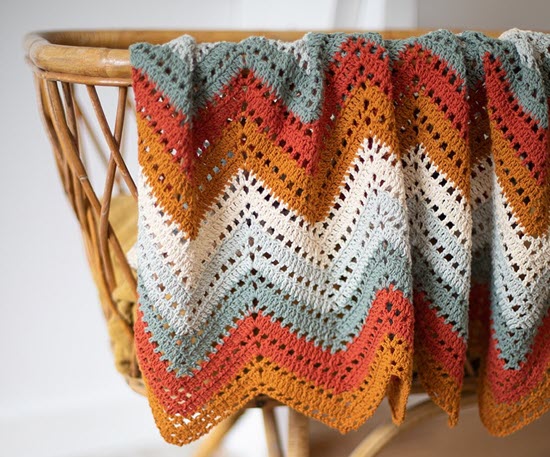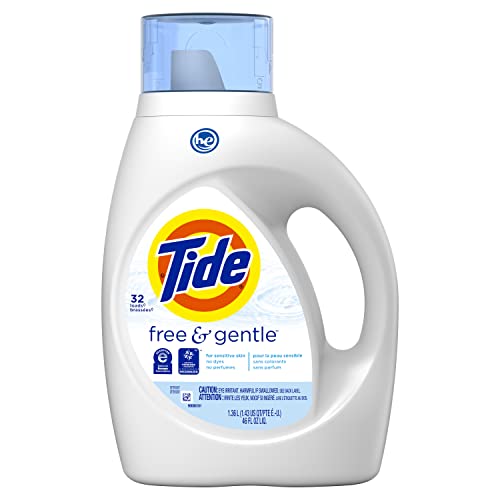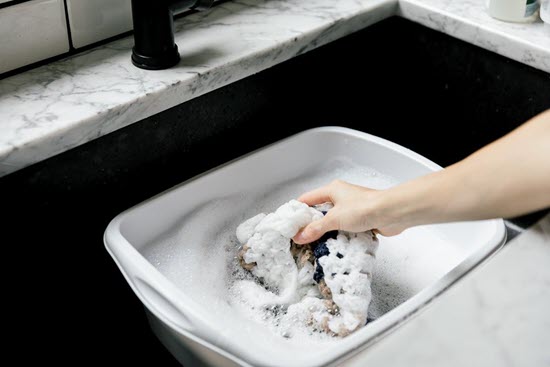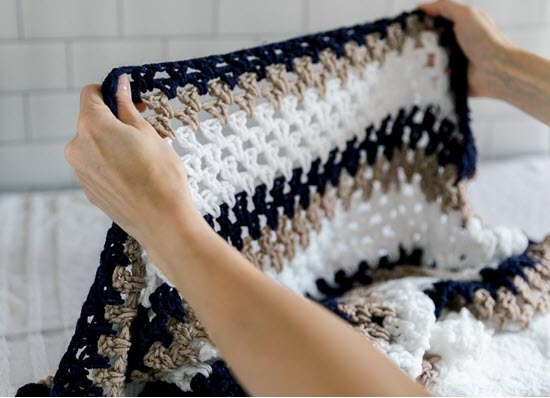Crochet blankets are a beautiful and cozy addition to any home, but their delicate nature may leave you wondering how to wash a crochet blanket properly. In this article, we’ll explore how to wash a crochet blanket safely and effectively while preserving its beauty and integrity.
First, it’s important to understand the fiber content and unique characteristics of your crochet blanket. This will help ensure proper washing technique and prevent damage during the cleaning process.
We’ll then discuss the pros and cons of handwashing and machine washing methods, so you can choose the method that best suits your blanket.
3 Key Takeaways for How to Wash a Crotchet Blanket
- Know your crochet blanket’s fiber content and characteristics for safe washing
- Learn about handwashing and machine washing methods to pick the best option
- Follow additional tips and cautions for special fibers and situations
Let’s dive deeper into how to wash a crotchet blanket.
In This Article
Understanding Your Crochet Blanket
Before going into a step-by-step process for how to wash a crochet blanket, it’s important that you understand all the different features of a crotchet blanket, from fiber type to proper care required.
Determine the Fiber Type
Your crochet blanket is made from yarn, and understanding the fiber content of the yarn is crucial for proper care. The most common types of fibers used in crochet blankets are cotton, wool, acrylic, ramie and blends of these fibers.
Each fiber type requires different care techniques. Look at the yarn label for information on the fiber content, which will help you determine the best way to wash and care for your crochet blanket.
Here’s a quick overview of common fiber types:
- Cotton yarn is soft, breathable, and absorbent. It can usually be machine washed and dried, but be sure to check the care instructions on the label.
- Wool yarn is warm and often delicate. Depending on the type of wool, it may require hand-washing or dry cleaning to prevent felting or shrinking.
- Acrylic yarn is lightweight and affordable. It is typically machine washable and dryer safe but can be sensitive to heat.
- Ramie yarn is a natural fiber made from a plant in the nettle family. It is strong and durable but may require gentle washing and drying.
Review the Care Instructions
It’s essential to follow the care instructions provided on the yarn label or included with your crochet blanket. These instructions can be a great guide to ensure you preserve the quality and longevity of your blanket when washing.
Care instructions usually come in the form of symbols that indicate acceptable washing, drying, and ironing procedures. Familiarize yourself with these symbols and adhere to them when caring for your crochet blanket.
In summary, when learning how to wash a crochet blanket, it’s important to remember that understanding the fiber type, as well as the care instructions, will help ensure your blanket remains in great condition. For example, you would never wash a crochet blanket the same way you’d wash a fleece polyester blanket.
Preparing Your Blanket for Washing
Before you begin learning how to wash a crochet blanket, it’s important to gather the necessary supplies and choose the right detergent for your blanket. In this section, we will discuss the steps for choosing the right detergent and gathering the necessary washing supplies.
Choose the Right Detergent
When washing your crochet blanket, it’s important to use a gentle soap or a mild detergent to avoid damaging the delicate fibers.
Some recommended options include:
Baby shampoo: These are usually formulated to be gentle on delicate items and can be used for washing crochet blankets.
Mild laundry detergent: Look for a detergent specifically designed for delicate items or with a gentle formula.
Castile Soap: You can also use a gentle soap, like castile soap.
It’s important to avoid using bleach or harsh detergents that can weaken or damage your crochet blanket.
Gather Your Washing Supplies
In addition to a mild detergent, there are a few other supplies you should gather so you know how to wash a crochet blanket easily:
- Laundry bag: A mesh laundry bag can help protect your crochet blanket from snags and tangles during the washing process.
- Mesh bag: Smaller mesh bags can be used for delicate items, like buttons or embellishments, that may come loose during washing.
- Towels: Gather a few dry towels to help you gently remove excess water from your crochet blanket after washing. A bath towel is a good choice for this purpose.
With these supplies and the right detergent, you are well prepared to wash your crochet blanket in a way that will preserve its quality and appearance.
How to Wash a Crochet Blanket: Hand Washing Technique
Soaking and Cleaning
To wash your crochet blanket:
- Begin by filling a sink or a large basin with lukewarm water.
- Dissolve a mild detergent in the water, taking care to avoid using harsh chemicals that could damage your delicate crochet.
- Submerge your blanket, gently agitating it using your hands to ensure it is fully soaked.
- Allow your crochet blanket to soak for 15-30 minutes, giving the detergent time to work.
During this time, you might want to read about how to make a blanket soft again. When the soaking time is complete, gently agitate the blanket, moving it around in the water to loosen any dirt or grime. Remember that tugging or pulling can damage your work, so be gentle and patient.
Rinsing and Removing Excess Water
After cleaning your crochet blanket:
- Drain the soapy water from the sink or basin.
- Fill the sink or basin with clean, lukewarm water.
- Submerge your crochet blanket, and gently agitate it to rinse out the soap. TIP: You may need to repeat this process several times until the water runs clear, ensuring no leftover detergent remains in your blanket.
Once your crochet blanket is completely rinsed, gently squeeze it to remove excess water. Avoid wringing or twisting the fabric, as doing so can distort or damage the fibers.
Instead, lay the blanket flat on a clean towel, and roll it up, applying gentle pressure to further remove excess water.
Reshaping and Drying
After squeezing out the water, carefully reshape your crochet blanket, returning it to its original dimensions. This is particularly important if the washing process caused it to stretch or shrink.
To help maintain the shape, use a technique called “blocking” by pinning your blanket to a foam or corkboard.
Next. find a suitable location for your crochet blanket to air dry. You can either use a flat surface that allows air to circulate, or a drying rack.
As you learn how to wash a crochet blanket, keep in mind that laying your crochet flat while drying will help prevent stretching and distortion.
Finally, never hang your crochet blanket to dry, as this can cause it to stretch and lose its shape.
How to Wash a Crochet Blanket: Machine Washing Method
Washing a crochet blanket can be a simple process if you know the right steps. In this section, we’ll guide you on how to wash a crochet blanket using a washing machine. Remember to be gentle with your blanket to avoid damaging the fibers.
Setting Up the Washer
- Choose the right washer: A front-load washer is recommended for machine washing crochet blankets because it is less likely to cause damage, as there is no agitator like in top-load washers.
- Select the detergent: Use a gentle laundry detergent or delicate shampoo to prevent damaging the fibers of your crochet blanket.
- Choose the temperature: Set the washing machine to use cold or cool water. Warm or hot water can cause shrinking or felting in certain yarns.
- Pick the cycle: It’s important to use a gentle or delicate cycle to protect the structure of your crochet blanket.
Here’s a quick summary in a table format:
| Washer Setting | Recommended Choice |
|---|---|
| Washer type | Front-load washer |
| Detergent | Gentle laundry detergent or delicate shampoo |
| Temperature | Cold or cool water |
| Cycle | Gentle or delicate cycle |
Drying Process
Once your blanket is washed, it’s time to dry it while still maintaining its shape and fibers. Follow these steps for the best results:
- Gently remove excess water: Before putting your crochet blanket into the dryer, gently squeeze out any excess water. Avoid wringing or twisting the fabric.
- Set the dryer: Choose a low heat setting on your dryer to prevent the yarn from overheating and becoming damaged.
- Keep an eye on the drying time: Check on your blanket periodically to ensure it doesn’t over-dry, as this can cause damage or shrinkage.
In conclusion, machine washing and drying your crochet blanket is a straightforward process. By following these guidelines, you’ll be able to maintain the integrity of your beloved crochet creation.
Special Care for Unique Fibers
When it comes to how to wash a crochet blanket made of unique fibers, specific care is required to maintain its longevity and beauty. Here’s a closer look at some common fibers used in crocheted blankets and some tips for washing them.
- Wool: Wool fibers in a crochet blanket require special care because of their natural characteristics. When washing, opt for a mild detergent, and always use cold water (hot water causes shrinkage). Hand washing is the best method, but if using a washing machine, select a gentle cycle. To avoid stretching, never wring out a wool blanket. Instead, gently squeeze out excess water and lay it flat to dry.
- Cotton: Cotton yarn blankets are typically more forgiving in the wash. You can use a mild detergent and cold water with a gentle cycle on a washing machine. However, to prevent shrinkage, it’s essential to lay your cotton crochet blanket flat to dry.
- Linen: Linen crocheted blankets are usually softer and more durable than those made of cotton. Hand washing is recommended, using a mild detergent and cold water. Like cotton, lay your linen blanket flat to dry to prevent unwanted shrinkage and stretching.
- Acrylic: Acrylic yarn can be quite tricky to care for as it is sensitive to heat and can stretch when wet. To wash an acrylic crochet blanket, use a gentle cycle with cold water and a mild detergent. Unlike other materials, acrylic can be tumble dried on a low heat setting. However, avoid using fabric softeners as they may leave a residue or cause the yarn to become too soft and lose its shape.
For more information on washing delicate blankets, you can visit this guide on how to wash a Minky blanket.
Additional Tips and Cautions
When learning how to wash a crochet blanket, it’s essential to know some additional tips and cautions to ensure proper care for your handmade treasure.
- Always check the label on your crochet blanket: which should provide essential information on the type of yarn or thread used and any care instructions. When in doubt, choose a gentle approach to keep your blanket in good condition. Caring for your crochet blanket means washing it every three to four months or as needed.
- Avoid using hot water: as it might cause your blanket to shrink or damage the yarn. Instead, opt for cold or lukewarm water when washing. It’s essential to be gentle while handling the blanket, too. Refrain from tugging or pulling to prevent the crochet work from getting distorted or stretched out.
- When it comes to using bleach, be cautious: It’s typically recommended to avoid bleach when caring for a crochet blanket, as it can weaken the fibers and cause colors to fade. Opt for mild laundry detergents or gentle fabric cleansers specially formulated for delicate items.
- To maintain your blanket’s original shape, hang it to dry. Lay the blanket flat on a clean surface or fold it over a drying rack, allowing air to circulate freely around it. Avoid hanging your blanket directly in the sun, as direct sunlight can cause the colors to fade.
- Don’t iron your crochet blanket. The heat can damage the fibers and possibly alter the texture of your masterpiece. If you need to remove wrinkles or smooth out the blanket, gently press it with your hands after washing and layout to dry.
By being careful and following these tips on how to wash a crochet blanket, you can preserve its beauty and enjoy it for many years to come.
Frequently Asked Questions
Final Thoughts on How to Wash a Crotchet Blanket
In conclusion, learning how to wash a crochet blanket is an essential skill for anyone who owns or creates these beautiful items. By understanding the proper cleaning techniques, you will ensure your crochet blankets maintain their unique appearance and feel for many years to come.
To recap the steps on how to wash a crochet blanket:
- Identify the yarn type
- Choose the appropriate washing method (handwashing or machine washing)
- Prepare your blanket and washing solution
- Gently agitate the blanket and let it soak
- Rinse thoroughly and remove excess water
- Dry the blanket correctly and handle it with care during storage
By following these guidelines, you can confidently and effectively clean your crochet creations without the fear of damaging them. Remember to always refer to the yarn label and maker’s recommendations when in doubt, and practice patience when handling these delicate items.
Now you know how to wash a crochet blanket. With the proper care, your crochet blankets will remain attractive and comfortable for years to come.













